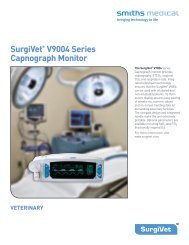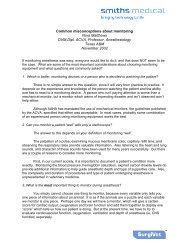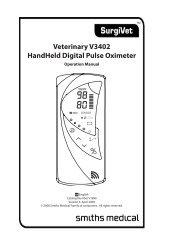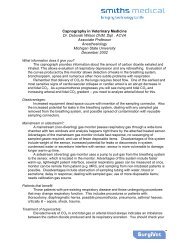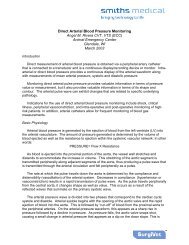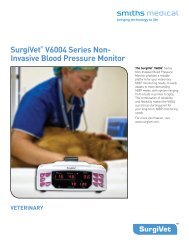Surgivet® V1030 Hand-Held Pulse Oximeter
Surgivet® V1030 Hand-Held Pulse Oximeter
Surgivet® V1030 Hand-Held Pulse Oximeter
You also want an ePaper? Increase the reach of your titles
YUMPU automatically turns print PDFs into web optimized ePapers that Google loves.
Chapter 1: Introduction<br />
WARNING! Measurements made at sites with low perfusion are potentially inaccurate.<br />
Always use measurements in conjunction with other clinical signs and<br />
symptoms.<br />
WARNING! SpO 2 measurements may be adversely affected in the presence of high ambient<br />
light. Shield the sensor area (with a surgical towel, for example) if necessary.<br />
WARNING! Dyes introduced into the bloodstream, such as methylene blue, indocyanine<br />
green, indigo carmine, fluorescein, and patent blue V (PBV) may adversely<br />
affect the accuracy of the SpO 2 reading.<br />
WARNING! Any condition that restricts blood flow, such as use of a blood pressure cuff or<br />
extremes in systemic vascular resistance, may cause an inability to determine<br />
accurate pulse rate and SpO 2 readings.<br />
WARNING! Optical cross-talk can occur when two or more sensors are placed in close<br />
proximity. It can be eliminated by covering each site with an opaque material.<br />
WARNING! Significant levels of dysfunctional hemoglobins, such as carboxyhemoglobin<br />
(with CO-poisoning) or methemoglobin (with sulfonamide therapy), will affect<br />
the accuracy of the SpO 2 measurement.<br />
WARNING! Tissue damage may result from overexposure to sensor light during<br />
photodynamic therapy with agents such as verteporphin, porfimer sodium,<br />
and metatetrahydroxyphenylchlorin (mTHPC). Change the sensor site at least<br />
every hour and observe for signs of tissue damage. More frequent sensor site<br />
changes/inspections may be indicated depending upon the photodynamic<br />
agent used, agent dose, skin condition, total exposure time or other factors.<br />
Use multiple sensor sites.<br />
WARNING! When connecting this monitor to any instrument, verify proper operation<br />
before clinical use. Refer to the instrument’s user manual for full instructions.<br />
Accessory equipment connected to the monitor’s data interface must be<br />
certified according to the respective IEC standards, i.e., IEC 60950 for data<br />
processing equipment or IEC 60601-1 for electromedical equipment. All<br />
combinations of equipment must be in compliance with IEC 60601-1-1 systems<br />
requirements. Anyone connecting additional equipment to the signal input<br />
port or the signal output port configures a medical system, and therefore is<br />
responsible that the system complies with the requirements of the system<br />
standard IEC 60601-1-1.<br />
WARNING! This monitor is suitable for use within the patient environment. IEC 60950<br />
approved equipment must be placed outside of the patient environment.<br />
The patient environment is defined as any volume in which intentional or<br />
unintentional contact can occur between the patient and parts of the system or<br />
between the patient and other persons touching parts of the system.<br />
1-4 Veterinary <strong>V1030</strong> <strong>Hand</strong>-<strong>Held</strong> <strong>Pulse</strong> <strong>Oximeter</strong> Operation Manual


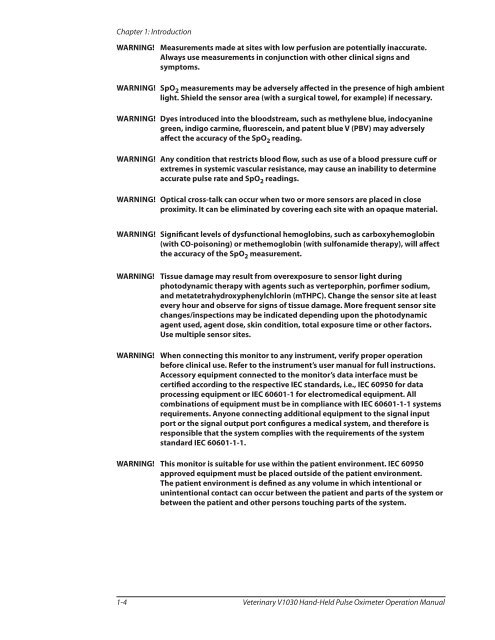
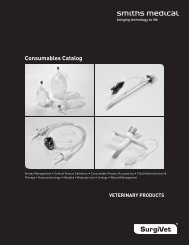
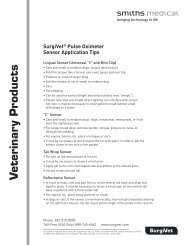
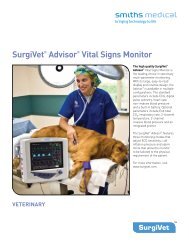
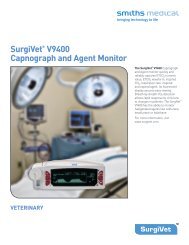
![Redemption Form [PDF] - SurgiVet](https://img.yumpu.com/37386077/1/190x245/redemption-form-pdf-surgivet.jpg?quality=85)
![Redemption Form [PDF] - SurgiVet](https://img.yumpu.com/37386066/1/190x245/redemption-form-pdf-surgivet.jpg?quality=85)
